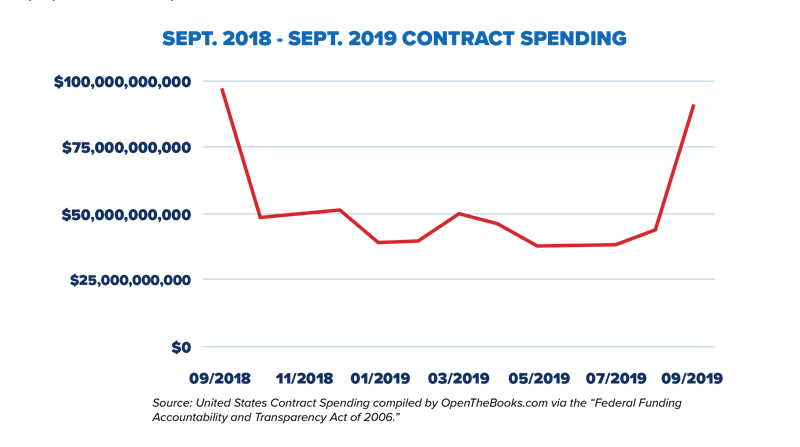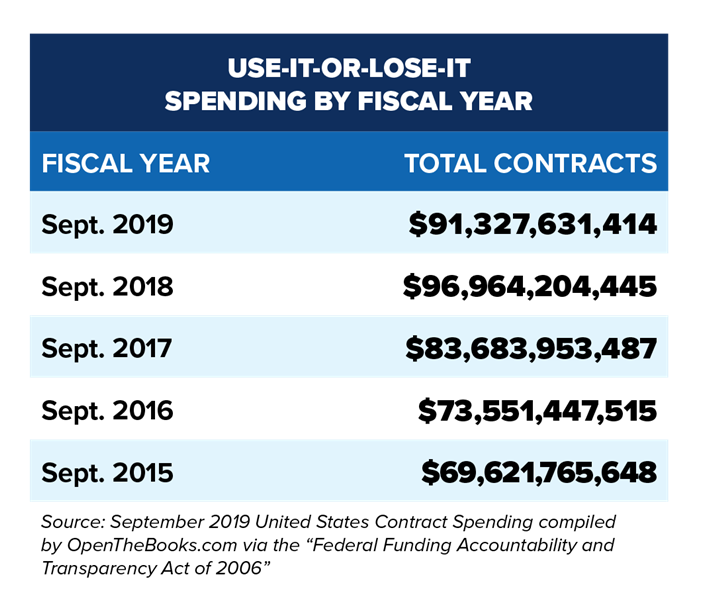



By Adam Andrzejewski
Christmas comes in September, not December, for federal contractors.
In the final month of the fiscal year, federal agencies scramble to spend the leftovers in their annual budgets. They worry that spending less than Congress appropriated this year will mean a thinner budget next year.
So, rather than admit the department could run efficiently on fewer taxpayer dollars, federal agencies embark on a shopping spree. This is the “use it or lose it” spending phenomenon – and it happens every year on the taxpayer dime.
Our OpenTheBooks oversight report – The Use-It-Or-Lose-It Spending Spree, How The Feds Spent $91 Billion In September 2019 detailed 642,567 transactions – or about 21,418 expenditures per day.

In the final nine days of the year, federal agencies signed $51 billion in contracts, which exceeded the spending in each of the trailing eleven months. In the final two days, agencies authorized a whopping $23.8 billion.
In February 2020, President Donald Trump committed to ending the bureaucratic binge-buying in his budget to Congress FY2021. So, we reached out to the budget hawks at the Office of Management And Budget (OMB) for comment.
OMB Director Russ Vought responded: “The practice of use it or lose it spending has cost American taxpayers an untold amount of money. It’s a practice that needs to stop and OMB will continue our efforts to end this wasteful spending.”
Furthermore, Vought held the agencies accountable, “Agencies rushing to get fiscal year spending out the door in order to meet their arbitrary spending quotas has only ended in millions of dollars in waste—leading to new golf carts and crab legs at agency parties.”
Here are ten ways bureaucrats spent your tax dollars in last year’s 2019 year-end shopping spree:
$50 million on lobster tail, crab, fish, and steak – As the fiscal year wrapped up, agencies splurged on luxury food items. The Department of Defense (DOD) reported spending $40.1 million on Mahi Mahi, salmon, and catfish. Another $4.6 million purchased lobster tail and crab – including snow crab, claws, legs, and clusters. Additionally, the DOD spent $400,000 on steak (ribeye, sirloin, and flank).
In addition, the Pentagon spent $100,000 on deserts including pastries, donuts, and pecan pie ($10,000).
$447.8 million on furniture – agencies signed nearly 13,042 contracts to purchase furniture in the last 30 days. Notably, the Pentagon spent $123.8 million on office furniture and the General Services Administration spent $10,084 on an entertainment unit. Counting other agencies such as Homeland Security and Veterans Affairs, purchased sit-to-stand desks ($3.3 million), white and bulletin boards ($1.1 million), and sofas ($328,514).
More than $500,000 on booze – Is the fiscal year-end one big party? The Pentagon and the State Department purchased beer and wine, much of which went to embassies and consulates around the world. Contract recipients included Coors Brewing Company TAP -0.4% ($59,282) and Carlsam-Samuel Meisel, Inc ($248,744).
$690.6 million loaded the gun locker – Eight departments made last-minute purchases of guns, ammunition, and other weaponry during the final month of the fiscal year. Even non-military agencies including Veterans Affairs (VA), Treasury, Interior, Education, Health And Human Services, Agriculture, and Labor spent $1.5 million in guns and ammunition.
For example, the VA purchased $650,964 worth of ammunition, handguns, and long guns – a “military police long gun program” with AR15-style weaponry.
Most interesting items – the Pentagon spent $2.4 million under the category heading “Saddlery, Harnesses, Whips, and related Animal Furnishing” – which could lead to all kinds of questions. However, the purchases were equipment for the military’s war dogs.
Health and Human Services (HHS) spent $32.8 million on an “advanced all-hazards” ventilator stockpile. Big question: Were the ventilators delivered in time for the pandemic? We requested comment from HHS.
$25.1 million on workout equipment and recreation – Fifteen agencies must have set new fitness goals when they spent $1 million on treadmills and elliptical equipment. Spending tax dollars is all fun and games according to the nearly $1 million agencies spent on playground equipment, bleachers, and a water slide.
$456.8 million public relations/self-promotion machine – Federal agencies spent millions on public relations, marketing research and public opinion, communications, and advertising in the final month of fiscal year 2019. The feds already employ 5,000 public affairs officers. It wasn’t enough.
Yes, agencies spent taxpayer dollars to convince taxpayers to shovel even more taxpayer money into the federal government next year.
$254.8 million on transportation – Driving up taxpayer costs, agencies signed 4,111 transportation-related contracts. The feds purchased passenger vehicles from Fiat Chrysler ($59.5 million), Ford Motor F -0.9% ($36 million), and General Motors GM 0.3% ($31.2 million). Additionally, the government purchased nontraditional vehicles including golf carts ($1.1 million), motorcycles ($100,741), and snowmobiles ($96,121).
Large contracts included the 4-door SUV for federal police use ($25.7 million) and various other SUVs ($75.1 million), pickups ($41.8 million), and sedans ($18.7 million).
$77.2 million on miscellaneous items – The last-minute shopping spree racked up $53 million in batteries, $23 million in books and pamphlets, $1.1 million on games, toys, and wheeled goods and $175,877 purchased paint and artist brushes. The Air Force Junior ROTC spent $49,883 on model rockets, up from $34,000 spent last year.
The Air Force responded to our comment request - Phil Berube, Air University Public Affairs: “Air Force JROTC has an annual requirement totaling $50K for model rockets based upon requests from its more than 890 units worldwide.”
$4.3 billion in contracts went to Boeing Corp BA -1.3%. – Despite the fact that 2019 was a very difficult year (think 737 Max), Boeing was the top recipient of year-end spending. Of course, Boeing spent $72.4 million lobbying during a recent five-year period. (In a ten-year period ending in 2017, for five-years, Boeing paid $0 federal income taxes.)

However, there is hope for bi-partisan reform.
On July 1, 2020, Rep. Adam Smith (D-WA), the powerful chairman of the U.S. House Armed Services Committee, after hearing from Rep. Seth Moulton (D-MA) – a former Marine Corps officer, stated in a hearing on the National Defense Authorization Act that he would back a floor amendment to stop use-it-or-lose it spending at the DOD.
In the U.S. Senate, Joni Ernst (R-IA) has led on reforms. Last summer, Ernst introduced S.1238, the Year-End Fiscal Responsibility Act – a reasonable bill that would stop the wasteful practice. Last week, Ernst gave her “Make ‘Em Squeal Award” to the five worst federal agencies that doled out the majority of the $91 billion in year-end 2019 contracts.
Sen. Ernst responded to our comment request: “At a time when lifesaving supplies are still hard to come by, even in many hospitals, binge buying bureaucrats need to curb their urge to splurge and focus the federal government’s purchasing power on pandemic essentials.
And Ernst is right when she says, “Federal agencies should show the same zeal for procuring personal protective equipment as they have consistently demonstrated buying unnecessary items like pecan pies and pastries.”
All of the pressure seems to be working.
Last year, the year-end spending decreased slightly from $97 billion (2018) to $91 billion (2019). It was the first time in five-years that the year-end spree decreased year-over-year.

As the federal debt approaches $27 trillion, it’s time to end Washington’s use-it-or-lose-it spending culture. Ending this wasteful phenomenon would go a long way toward generating big savings, changing the culture of taxpayer abuse, and winning the public’s trust.